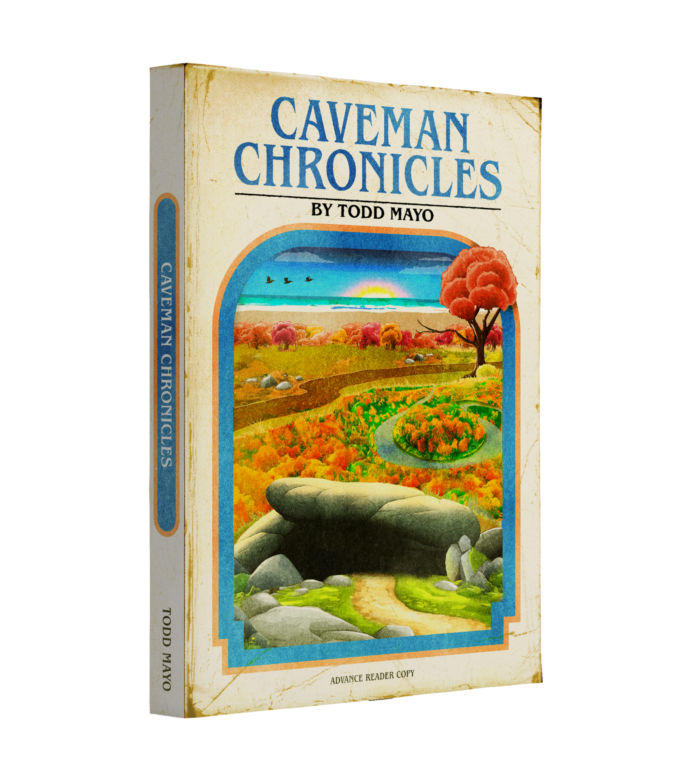photo: Michael Weintrob
***
“It was about an hour before opening night,” Todd Mayo writes in the first chapter of his new memoir, The Caveman Chronicles. “Soon, 850 people would be streaming into this underground wonderland I had first dreamed, then ‘realitied’ up. Or was it down? Sometimes it’s hard to tell up from down when you’re a caveman. I was 46 years old that day, opening night at The Caverns—a mythic and epic music venue I ‘discovered’ and, with a team of other dreamers and doers, built into something that would stand the test of time. Geological time that is. Human time is different. I was born looking forward but now, or rather then, my mind was untethered and flowing backwards to a time 10 years before, when my dreaming became entwined with doing. My head was always in the sky, but my feet always felt like they were on unsteady ground.”
The preceding passage offers a fine introduction to the book’s themes. The Caveman Chronicles shares Mayo’s account of growing up in the Volunteer State during the 1970s and ‘80s. With humility and humor, Mayo relates some of the struggles he faced while serving as a caretaker for family members, as well as the challenges he experienced working gigs in radio and sales. Mayo also describes the momentous day in 2008 when happenstance led him to visit Cumberland Caverns, where he instantly envisioned how it could be utilized as a music venue and then set that plan in motion. A decade later, he did it all again when necessity and serendipity led him to pull up stakes and relocate to Big Mouth Cave, where he will be hosting the third annual CaveFest .
As Kirkus Reviews says of The Caveman Chronicles: “In Mayo’s debut memoir, necessity and fatherhood help a longtime gambler strike music gold.”
What prompted you to write the book?
What happened was that in March of 2020 when COVID hit, those of us in the music business—and in any sort of live-people business—were economically on the front lines. We were sort of cannon fodder because everything stopped. I can remember being down inside the cave and I came out and had a hundred text messages. Basically everything got postponed on that one Thursday.
Then by April, we realized this wasn’t going to be a couple of weeks. It was dire for us because I’m an independent venue owner, independent promoter. So it was like, “Oh God, we’re going to go out of business, and all of this is about to go away.” It wasn’t just that shows were being postponed, they were being canceled.
I don’t reflect on the past very often, but at that moment in time, I started looking backward. Up to that point, I had sort of found my purpose in life and my dreams had come true. So when this act of God or Mother Nature said, “This is all going to go away,” it made me look backward at my life. I had time to do it because we certainly weren’t doing any shows. So I started writing the book in April 2020.
I wrote into the first couple months of ‘21 and it was really therapeutic. It helped me deal with things, while having a real understanding of all the crazy stuff that has happened in my life. Looking back helped me realize, “This isn’t going to be the end of the world. You’ve got to keep on pushing through.”
Now I’d heard of Carl Jung and Joseph Campbell, but I’d never read any of that. Then after the book was written, I started really getting into it. There’s something we play every day in The Caverns when people take a tour and it goes into the darkness—we call it “The Hero’s Journey.” I think the book, externally, is a story about how The Caverns came into being. Then internally, I didn’t set out to write a spiritual book, but that’s what it is—to me anyway.
As I reflected on what I had written, I was like, “Wow, when I really look at my path, I can see where the more selfless I became, and the more I got out of my own head, the more that serendipity, coincidence, synchronicity, providence or fate—whatever you want to call it—would happen.” So that’s really the main theme of it for me.
There is that singular, compelling moment when you walk into Cumberland Caverns in 2008 and have an epiphany that you’re also able to actualize.
It started with that year in caregiving. The second to last chapter, “Leggo My Ego,” goes back to the point in time when it all really began. That softening of my heart led to me being married and having a true relationship with a woman, then becoming a father and all these things followed. All of a sudden, that was my path. For other people, there are different paths, but that’s what it was for me.
The book opens up with a chapter called The Eagle and the Child. The eagle is the symbol for the freedom that I felt professionally when I left the corporate world and went out on my own [starting an ad agency and taking over an AM sports[1]talk radio station]. Then, of course, the child is my son being born. Both of those things were happening concurrently during 2007, and that was why I started the book there.
If somebody asked me how I came up with this, I’d say, “Ah, it’s the same old story. You’ve heard it a hundred times. A guy walks into a cave…”
It was not necessarily the first time that somebody had come up with that idea, but it was the first time somebody had that idea despite having no experience in the music business—but who understood enough and yearned enough and was at a point in their life to be able to make it happen in seven weeks because now they’re a father and they said, “I’m going to figure this out.”
So I was able to get it on WSM radio, find a sponsor and book The SteelDrivers. I was able to be a music producer or a music promoter, despite having never done it before. I was able to visualize doing all that after I set foot in the cave. That was the head-in-the-sky part. But I was able to do it because I had just enough experience and connections, and just enough ignorance, not to be scared. When you’re an entrepreneur, sometimes what you don’t know is much more important than what you know.
But if I had walked into that cave five or 10 years before and had an idea like that, it would’ve been one of my Walter Mitty daydreams that never went anywhere. I had spent my whole life sort of daydreaming about things—yearning, but not doing. However, this time I had the confidence, and a lot of that for me was tethered to being a father.
Shortly after you began Bluegrass Underground, you also started working on the Music City Roots radio show. You were doing both of those simultaneously. Was there a moment when you felt like you were in over your head?
The first show in the cave was August 2008 with The SteelDrivers. Then, just two months later, in October, me and John Walker met about what originally was called Back to the Barn and became Music City Roots. To me, it was a big deal just to produce one show a month—make it a live event and a two-hour radio show and edit the radio show—especially with a brand-new advertising agency and a brand-new baby.
But I had such a sense of purpose, and it all felt meant to be. I was like, “Man, I’m getting some at bats for whatever reason and this can go somewhere. I can see it.” So I had an unlimited amount of energy to step into booking four artists a week for Music City Roots, producing that and selling sponsorships—plus working at my ad agency. And then Todd Squared started with the TV production company. I sort of looked up and, all of a sudden, I was wearing four different hats with four different partners every day.
It was manic in its intensity, but it wasn’t manic in its follow through or in the day-to-day reality because I got really good at wearing one hat. Then when it was time, I would take that hat off and put another hat on. Then I’d take the other one off and put another one on.
At Music City Roots, we were doing livestreaming every week when Netflix was still mailing people DVDs. Another thing is you would come to those shows and it would be old people and young people, urban people and rural people, hipsters and dorks—just everybody together. The artists would all be different. It’d be a rock band, and after that it would be a bluegrass band. Then you’d have an indie thing, then you’d have a blues artist, then everybody would come together at the end and perform. It was a joy because through the power of music, we were bringing people together.
By 2017, you realized you would have to move out of Cumberland Caverns and try to find a new home. How challenging was it to locate a suitable cave?
Again, it was serendipity. I said to Joe Lurgio, my right-hand man, that life really is the ideal and the reality. We all start with the ideal, then reality intercedes and that’s what life is. The cave was the opposite. The reality of Cumberland Caverns was epic, and I never wanted anything more, but it wasn’t ideal. It wasn’t a permanent venue, it wasn’t their core business. The guy that owned it was basically trying to screw me and it was too small. So then it was like, “OK, what’s the ideal?” I said to Joe Lurgio: “There are 8,000 caves in this state. We’ve got to find our own.” But to say something like that and then have it come true— there might be 8,000 caves but we needed a cave that could be a music venue, which is a super rare thing. Even among show caves, you’d still need a room that would be suited for it.
Then a caver friend of Joe’s named Buck heard about Big Mouth Cave, this cave in Grundy County, Tennessee that wasn’t on a map. If you would’ve given me a map and asked me where I’d want the cave of my dreams to be located, I would’ve said, “Between Nashville and Chattanooga, off the interstate.” Well, that’s where it was. Talk about serendipity—when we went in there, it wasn’t even for sale. It was owned by 12 people and I had to approach them through my friend Elizabeth because I couldn’t say Bluegrass Underground was coming to town or else the price would go up.
Once I had a 90-day period for due diligence to see if I could make it work, I wasn’t sure how I could do that without the news getting back to Cumberland Caverns—which could jeopardize everything if this cave wasn’t suitable. My friend Elizabeth said, “You should talk to my brother,” who was named Temple. We got on the phone and it turned out he did football stadium renovations, but he also did all kinds of stuff underground. So when we went out there, he knew the geologist and the hydrologist. Suddenly, I had a team around me of capable people who could actually say, “Yeah, Todd, this is doable.” Then we just started doing it.
I’d say there are two things above everything that make me so happy and proud beyond just seeing music in the cave. That’s going into the parking lot, looking at the license plates and meeting people from all over the country. There’s no feeling like knowing that people are making a pilgrimage to come to this place from all over. We had John Summit, this big EDM artist who just played Madison Square Garden, and we had people come from 31 countries and all 50 states. But the other thing is that people who work at The Caverns maintain this total family vibe. When you go to our Tripadvisor or our Google reviews, you get as many people talking about an encounter they had with somebody in the box office or the merch or the bathrooms or the concessions or the parking, as they do about anything else.
Sometimes it feels like it’s I Dream of Jeannie and people are getting blinked into existence when we need them to do something, but then they become part of the family.
That’s where you have to laugh in a joyful way at the serendipity. As hard as it’s been— and as many ups and downs as we’ve had and as much as it all seems to be on the edge of a knife and like it could fail at any moment—it’s been a wonderful ride with a great soundtrack.
Over the past few years, beyond the time span you detail in the book, you’ve expanded with an amphitheater and then CaveFest. How long had you been thinking about all that?
It is interesting because on a parallel track to writing this book and looking back at the past, we were building bridges to our future, just trying to stay in business.
So the amphitheater was a direct result of trying to be able to do shows safely during COVID. We had four nights of Jason Isbell, and that’s what allowed us to build it. I told Andrew Colvin, Jason’s booking agent, “Have you ever seen Field of Dreams? ‘If you build it, they will come.’ Well, if Jason comes, we’ll freaking build it.” We needed an artist like him to say that they’ll do it. Then, once he did, we built an amphitheater over five weeks during the fall of 2020, which is just amazing. Moving 500 truckloads of dirt and tiering out an amphitheater and putting in a stage—it’s really insane what we did. But to look at it now and see how beautiful the backdrop and the mountains are, it’s amazing.
I’d never walked that space and said, “Oh, we’re going to have an amphitheater.” Somebody said that if necessity is the mother of invention, then desperation is the father—well, we had a need to do something. We were desperate, so we did it.
Then, once we pushed through COVID into 2022, we had this amphitheater, and we did a lease with local farmers for 50 acres that we could use for campgrounds. So then it was like, “Well, now we can do music festivals.”
That was not part of the original pre-COVID vision at all. But the vision has kind of grown. At this point, 73% of all of our patrons come from outside the state of Tennessee, which is amazing.
We’ve built 20 yurts, and to be able to provide accommodations for people and to have other things for them to do is part of the vision now. So it keeps evolving.
It’s such a unique space to do boutique music festivals because we can park and camp 4,000 people, and that’s a great number of people to come together to experience music. At CaveFest, there’s a cave stage running at the same time as an amphitheater stage, and then people go back to the campgrounds. It’s a field surrounded by mountains, and there are different vibes and different places. There’s even this beautiful trail when you walk from the back of the amphitheater to the campgrounds. It’s a magical walk in its own right where I’ve got little homages to my C.S. Lewis and Tolkien-loving self. There are little posts that light the way back there.
It’s so cool to see how things evolve, not just the vision of it, but the execution of it. It’s driven not only by people’s yearning to feel the feeling that music gives, but also to have a mythic experience in nature. That’s the real magic of The Caverns. One plus one equals three.
Look, art itself emerged from caves. The first examples we have of art—visual art and paintings—are in caves. You can imagine that they were making music as well. I think there’s something that resonates with people when they come into a cave to experience music. I think it’s tapping into 50,000 years or more of genetic memory and that just makes it special.
What a joy to have walked in and to have had that idea and been able to follow through and make it work—because I guarantee you, I’ve had a thousand other ideas that didn’t work. [Laughs.]
The post Todd Mayo: The Caverns’ Caveman Shares His Chronicles appeared first on Relix Media.





















